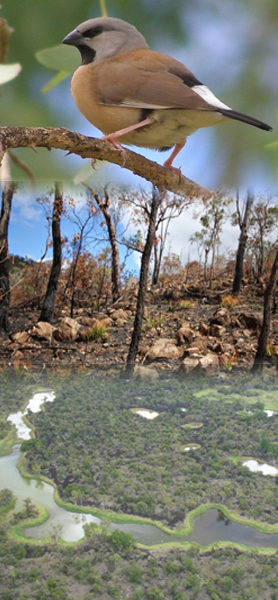Protecting Biodiversity
The Protecting Biodiversity Program of NQ Dry Tropics supports the community to protect, maintain and restore biodiversity in the Burdekin Dry Tropics region. We provide planning direction, advice, information, and practical support to mobilise community efforts in achieving this.
The Protecting Biodiversity Program has been structured with two thematic areas that focus on reducing the threats and impacts and improving the condition and extent of biodiversity values within the region.
Biodiversity provides numerous values to the region and its community and can be explained through the three important concepts of:
- Ecosystem Services – the benefits that natural elements of the landscape (e.g. soils, water, vegetation, wildlife) provide to humans (e.g. sustainable grazing),
- Resilience – the ability of country to absorb disturbance (e.g. droughts, floods, fires) and recover quickly (bounce back) without dramatically changing,
- Threshold – the point where there is no recovery and the country changes.
NQ Dry Tropics takes a whole of landscape approach to biodiversity management. The program is informed by the best available science, together with existing plans such as the Burdekin Dry Tropics Regional Pest Management Strategy. Key objectives of the program include:
- reducing the impacts of priority pest and weed species,
- building regional capacity to effectively manage priority pest and weed species,
- targeting investment for prevention and early intervention of new and priority invasive species
- supporting the recovery of Environmental Protection and Biodiversity Conservation Act 1999 (EPBC Act) listed species by addressing priority threatening processes, and
- engaging the community and increasing participation in the protection of keystone ecosystems.
Emergency Preparedness and Response plan
Burdekin Dry Tropics Biodiversity and Agricultural Natural Capital Emergency Preparedness and Response Plan: NQ Dry Tropics led the development of an Emergency Preparedness and Response Plan to protect the biodiversity and agricultural natural capital in the Burdekin Dry Tropics.
The primary objective of the plan, available here, is to enhance preparedness and response to natural disasters by integrating biodiversity and agricultural natural capital into emergency planning. This will help improve the resilience and recovery of these critical assets.
Current Protecting Biodiversity projects
From the Land to the Sea: Improving the Health of Coastal Ecosystems
This project aims to improve the health of coastal ecosystems by reducing the threats to the region’s Outstanding Universal Value World Heritage properties, including the Great Barrier Reef, the Bowling Green Bay Ramsar wetlands and the Wet Tropics World Heritage Area. Read more…….
Coordinated Regional Pest and Weed Management in the Burdekin Dry Tropics
Pest plants and animals are a serious threat to our region’s economic, social and environmental sustainability. They adversely affect the healthy function of ecosystems, reduce primary industry productivity and profitability, and can have significant impacts on a raft of social, recreational and health values. Read more…….
Conservation Action Planning (CAP)
NQ Dry Tropics’ Protecting Biodiversity programme supports the Burdekin Dry Tropics community to protect, maintain and restore biodiversity in the region. It does this by facilitating and administering a regional governance framework that enables the community to:
● assess the distribution and status of biodiversity, habitat condition and future threats
within the region;
● scope landscape-scale biodiversity projects, and establish goals and strategies to protect,
maintain and restore values; and
● objectively, consistently and transparently manage actions, and their intended and actual
outcomes. Read more…….
Protecting Beach Scrub
This project aims to enhance and monitor the health of coastal semi-evergreen vine thicket sites around Townsville, Magnetic Island, Ayr, Cape Upstart, and Bowen (“Beach Scrub”: Regional Ecosystem 7.2.2 and 11.2.3, EPBC listed as Critically Endangered and Endangered resp). Read more…….
Conserving Brigalow Corridors
The NQ Dry Tropics’ Conserving Brigalow Corridors in the Burdekin project, funded through the Australian Government’s National Landcare Program 2, is helping landholders increase the connectivity between brigalow corridors by improving the quality of brigalow habitat. Read more…….
Linking Burdekin Landholders to their frontage country
NQ Dry Tropics is working with landholders in the Upper Burdekin catchment to find ways to manage grazing pressure to maintain productive frontage pastures and minimise impacts on waterways and wetlands. Read more…….
Healing Country
A $1.37 million Queensland Government investment will enable the second phase of NQ Dry Tropics’ Healing Country project that connects young First Nations people with Country while helping to improve land condition and reducing sediment run-off. Read more …
Completed Protecting Biodiversity Projects
Bio Corridors and Landscapes Connectivity (Species Recovery)
The Species Recovery project aimed to increase community participation in the management and protection of important ecosystems and EPBC Act listed threatened species. We have done this by providing landholders with skills, knowledge, management tools and investment opportunities. Read more………..
Beach Scrub Project (CAP) 2016-2018
The Beach Scrub Project was an Australian Government funded initiative, through the National Landcare Programme, to improve the condition and extent of beach scrub in the NQ Dry Tropics region. The Beach Scrub Project aimed to promote conservation of beach scrub semi-evergreen vine thickets, an endangered ecosystem that’s crucial for reducing erosion and preserving strong ecological diversity on-property. Read more………..
Black-throated Finch Project (CAP) 2017-2018
The Black-throated Finch (BTF) Project was an Australian Government funded initiative, through the National Landcare Programme. The BTF Project aimed to have viable (increasing) populations of BTF across 10,000 ha of identified habitat by 2030. BTF perform many important ecological functions, including helping to spread grass seed, vital to maintaining their habitat and native pastures. Read more………..

